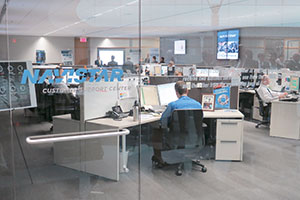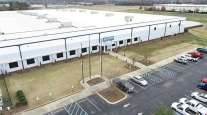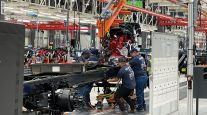'Uptime' Becomes a Focus of Navistar's Turnaround

This story appears in the Feb. 9 print edition of Transport Topics.
LISLE, Ill. — Navistar Inc. declared a renewed focus on building increasingly dependable trucks and providing enhanced support to its customers to keep them on the road, beginning the next phase of its quest to regain market share and return to profitability.
The truck maker’s emphasis on “uptime” includes improvements to the trucks and more efficient service and repairs through its dealer network and remote diagnostics technology, executives said at the company’s 2015 analyst day here Feb. 4.
“We believe we can gain a competitive advantage by being the uptime leader in our industry,” CEO Troy Clarke said during the briefing.
The new company mantra, “It’s uptime at International,” was repeatedly spoken by Navistar’s leaders and appeared on signs throughout its headquarters.
That uptime message also reflects Navistar’s desire to further turn the page on the failure of its previous engine-emissions strategy and the diminished reliability associated with that generation of trucks, which featured “Advanced EGR,” or exhaust gas recirculation.
Over the past two years, Navistar has been transitioning its truck lineup to selective catalytic reduction emission technology, a process that Clarke said is “essentially complete.”
The company accomplished that goal by offering Cummins engines in its trucks and adding SCR to its own MaxxForce engines.
Clarke acknowledged that Navistar experienced higher warranty costs for its EGR engines than originally expected and that its market share hasn’t recovered as quickly as it had hoped.
Looking forward, Navistar officials said strides have been made in improving reliability and reducing the time and cost of repair work.
Repair rates for International ProStar models with 2013 SCR MaxxForce engines have dropped by half compared with ProStars with 2010 EGR engines, according to the company.
A key component of Navistar’s uptime focus is its OnCommand Connection remote diagnostics platform, which monitors a truck’s health as it moves down the road and helps coordinate parts and service support when needed.
OnCommand, first introduced in October 2013, collects data on 80,000 vehicles, according to the company.
This year, Navistar aims to capitalize on continued growth in the North American truck market, said Bill Kozek, president of the truck and parts business.
“Improved new-truck fuel economy, rising tonnage and improved transportation company profitability will continue to generate higher demand for Class 8 on-highway vehicles this year,” he said.
Navistar projected industrywide sales of Classes 6-8 trucks and buses will grow to 368,000 units this year, up from 342,000 in 2014.
The company aims to sell 26,800 to 27,800 on-highway Class 8 trucks during its fiscal year ending in October. That would be about a 4% to 8% increase from 25,800 units in fiscal 2014.
Navistar expects its strongest growth this year to be in the medium-duty range, where it anticipates selling 19,000 to 20,000 trucks, up from 15,000 in 2014, driven by expanded coverage of its DuraStar model with the Cummins ISB engine to nearly all applications.
A day earlier, Navistar announced the availability of the ISB in its WorkStar vocational truck. Navistar said it anticipates selling 9,300 to 10,300 severe-service Class 8 trucks this year, up from 9,000 in 2014.
Chief Financial Officer Walter Borst said Navistar has slashed structural costs by $650 million and cut manufacturing costs by $120 million since the beginning of 2013.
Borst said Navistar expects to see year-over-year improvement in adjusted earnings before interest, tax, depreciation and amortization in each quarter of 2015, but he didn’t say when it expects to turn a profit.
Navistar has reported losses in each of its past nine fiscal quarters, although it narrowly missed the break-even point in its third quarter ended July 31. Stephen Volkmann of Jefferies & Co., one of the analysts in attendance at the event, told Transport Topics that Navistar’s turnaround efforts thus far have resembled “three yards and a cloud of dust,” with a little bit of progress each quarter.
While some truck manufacturers have been promoting vertical integration with a focus on selling more of their proprietary engines, transmissions and components, Navistar has moved in the opposite direction since its switch to SCR.
“We’re taking a different approach,” said Dennis Mooney, group vice president for global product development. “We’re going to leverage our global suppliers and our partners to offer what we think is leading-edge technology and, maybe more importantly, more choice.”
Navistar’s renewed relationship with Cummins represents a shift from its approach just a few years ago, Mooney said.




